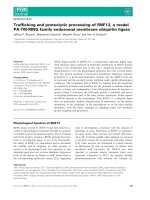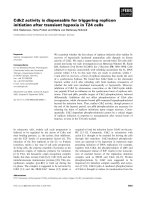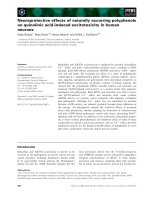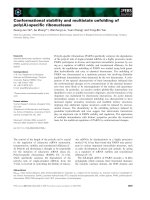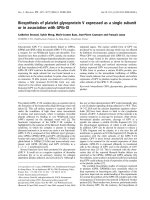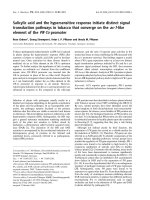Báo cáo khoa học: "Leaf area and tree increment dynamics on a fertile mixed-conifer site in southern Finland" doc
Bạn đang xem bản rút gọn của tài liệu. Xem và tải ngay bản đầy đủ của tài liệu tại đây (938.05 KB, 11 trang )
Original
article
Leaf
area
and
tree
increment
dynamics
on
a
fertile
mixed-conifer
site
in
southern
Finland
Kevin
L.
O’Hara*
Erkki
Lähde,
Olavi
Laiho
Yrjö
Norokorpi,
Timo
Saksa
Finnish
Forest
Research
Institute,
Parkano
Research
Station,
Kaironiementie
54,
39700
Parkano,
Finland
(Received
3
March
1998;
accepted
16
June
1998)
Abstract -
Ratios
of
volume
increment
to
photosynthetic
area
were
used
to
provide
measures
of
growing
space
efficiency
in
Scots
pine
(Pinus
sylvestris
L.)
and
Norway
spruce
(Picea
abies
(L.)
Karst.)
dominated
stands
on
a
productive
site
in
southern
Finland.
Eight
plots
were
established
in
a
stand
treatment
study
and
three
plots
in
nearby
untreated
Scots
pine
stands.
Treatments
included
low
thinnings,
individual
tree
selection
cuttings
and
untreated
controls.
Projected
leaf
area
of
individual
trees
was
represented
by
sap-
wood
cross-sectional
area
at
the
crown
base.
Ratios
of
volume
increment
to
leaf
area
index
(LAI)
for
stands
and
species,
and
ratios
of
volume
increment
to
sapwood
cross-sectional
area
were
used
to
assess
the
relative
growing
space
efficiency
of
stand
components.
LAI
was
greatest
in
stands
dominated
by
Norway
spruce.
Strong
relationships
were
observed
between
individual
tree
volume
incre-
ment
and
sapwood
area
of both
Scots
pine
and
Norway
spruce.
For
both
species,
these
relationships
were
improved
when
developed
separately
for
lower
and
upper
crown
classes.
(©
Inra/Elsevier,
Paris.)
Picea
abies
/
Pinus
sylvestris
/
leaf
area
index
/
crown
efficiency
/
mixed
species
Résumé -
Surface
foliaire
et
dynamique
d’accroissement
des
arbres
dans
des
peuplements
mélangés
de
conifères,
dans
une
station
fertile
de Finlande
méridionale.
Les
rapports
entre
l’accroissement
en
volume
et
les
surfaces
photosynthétiques
ont
été
utili-
sés
pour
mesurer
l’efficacité
de
l’espace
disponible
pour
la
croissance
des
arbres
dans
des
peuplements
mélangés
de
pin
sylvestre
(Pinus
sylvestris
L.)
et
d’épicéa
commun
dans
une
station
fertile
de
Finlande
méridionale.
Huit
placettes
ont
été établies
dans
les
peu-
plements
étudiés
ainsi
que
trois
placettes
à
proximité
dans
un
peuplement
de
pin
sylvestre.
Des
éclaircies
par
le
bas,
des
coupes
de
sélections
d’arbres
individuels
et
des
témoins
non
traités
étaient
pris
en
compte
dans
cette
étude.
L’indice
foliaire
des
arbres
indivi-
duels
était
représenté
par
la
surface
de
la
section
transversale
du
bois
d’aubier
à
la
base
de
la
cime.
Les
rapports
entre
l’accroissement
en
volume
et
l’indice
foliaire
pour
les
peuplements
et
les
espèces,
et
les
rapports
entre
l’accroissement
en
volume
et
la
surface
de
la
section
transversale
du
bois
d’aubier
ont
été
utilisés
pour
évaluer
l’efficacité
relative
de
l’espace
d’accroissement
des
composantes
des
peuplements.
L’indice
foliaire
était
le
plus
élevé
dans
les
peuplements
dominés
par
l’épicéa
commun.
De
bonnes
relations
entre
l’accroissement
en
volume
d’arbres
individuels
et
la
surface
de
l’aubier
du
pin
sylvestre
et
des
épicéas
ont
été
observées.
Pour
les
deux
espèces,
ces
relations
ont
améliorées
en
séparant
les
classes
de
cimes
supérieures
des
classes
inférieures.
(©
Inra/Elsevier,
Paris.)
Picea
abies
/
Pinus
sylvestris
/
indice
foliaire
/
efficacité
des
couronnes
/
essences
mélangées
1.
INTRODUCTION
Leaf
area
index
(LAI),
or
the
ratio
of
projected
foliage
area
to
ground
surface
area,
provides
a
useful
measure
of
forest
site
utilisation,
particularly
in
light-
limited
environments.
The
amount
of
foliage
generally
increases
during
even-aged
stand
development
to
reach
a
maximum
steady-state
level
that
is
related
to
site
*
Correspondence
and
reprints:
145
Mulford
Hall
#
3114,
University
of California,
Berkeley,
CA
94720-3114,
USA;
quality
[12,
16,
33].
Leaf
area
index
can
also
be
inter-
preted
as a
representation
of
occupied
growing
space
[19, 21].
For
stands
at
less
than
the
maximum
or
poten-
tial
LAI,
some
growing
space
can
be
assumed
to
be
unused.
The
ratio
of
occupied
or
actual
LAI
to
potential
LAI
therefore
provides
a
measure
of
relative
site
utilisa-
tion.
For
a
stand
which
received
a
thinning
treatment,
the
reduction
in
density
is
used
to
reallocate
LAI
or
growing
space
to
fewer
trees.
The
initial
result
will
be
a
lower
level
of
growing
space
occupancy.
Stand
volume
incre-
ment
may
be
substantially
lower
following
the
treatment
if
the
reduction
in
growing
space
occupancy
is
great.
However,
the
reduction
in
volume
increment
is
diffi-
cult
to
predict
from
only
LAI
because
of
variations
in
productivity
of
leaf
area
in
different
parts
of
the
stand.
For
example,
crown
classes
in
even-aged
stands
will
typ-
ically
have
different
ratios
of
tree
increment
to
leaf
area
with
codominants
generally
the
highest
[4,
19].
These
ratios
of
tree
increment
to
leaf
area
can
be
interpreted
as
’growing
space
efficiencies’
(GSEs)
[19].
Various
com-
binations
or
structures
of
trees
with
different
GSEs
can
have
different
productivities
in
both
thinned
and
unthinned
stands
even
when
total
growing
space
occu-
pancy
is
constant
[20].
These
differences
in
GSE
between
trees
in
different
crown
positions
present
opportunities
for
manipulation
of
stand
structures
to
enhance
stand
productivity.
Concepts
related
to
growing
space
or
leaf
area
efficiency
are
relatively
new
and
are
not
integrated
into
stand
man-
agement
procedures.
However,
the
strong
relationships
between
tree
growth
and
tree
leaf
area
indicate
that
there
is
potential
for
researchers
to
develop
stand
management
procedures
once
the
dynamics
of
leaf
area
and
tree
growth
are
known.
Mixed-species
stands
present
an
additional
complica-
tion
over
single-species
stands.
A
more
shade
tolerant
species
will
support
greater
amounts
of
foliage
over
a
longer
average
crown
depth
than
a
less
tolerant
species.
The
adaptation
of
the
more
tolerant
species
to
photosyn-
thesize
over
a
range
in
canopy
depth
results
in
a
reduc-
tion
in
total
photosynthesis
efficiency
that
is
compensat-
ed
by
the
larger
photosynthetic
capacity
or
leaf
area
of
the
tree.
Hence
comparisons
of
the
growing
space
effi-
ciency
of
a
tolerant
and
intolerant
tree
are
difficult.
Few
studies
have
examined
leaf
area
dynamics
in
mixed
conifer
stands.
Schroeder
et
al.
[29]
found
increasing
volume
increment
with
increasing
LAI
in
mixed
conifer
stands
in
several
distinct
environments
in
the interior
Pacific
Northwest
of
North
America.
However,
no
information
on
individual
productivity
by
species
was
provided.
Smith
and
Long
[30]
examined
the
relative
contributions
of
lodgepole
pine
(Pinus
con-
torta
var.
latifolia
Dougl.)
and
subalpine
fir
(Abies
lasio-
carpa
Hook
(Nutt.))
in
mixed
stands
in
the
central
Rocky
Mountains
of
North
America.
LAIs
and
relative
shade
tolerance
were
higher
for
pure
subalpine
fir
than
for
lodgepole
pine.
Mixed
stands
were
of
intermediate
LAI.
Stand
volume
increment
decreased
as
the
percentage
of
lodgepole
pine
increased,
and
no
synergistic
effects
of
the
mixed
species
interaction
were
observed
[30].
As
a
European
application,
this
paper
presents
results
from
a
leaf
area
study
in
Scots
pine
(Pinus
sylvestris
L.)
and
Norway
spruce
(Picea
abies
(L.)
Karst.)
dominated
forests
in
southern
Finland.
The
objectives
were
to
examine
patterns
of
growing
space
efficiency
from
the
stand
(plot),
species
and
tree
level
to
develop
a
prelimi-
nary
stand-level
stocking
allocation
model
for
silvicul-
ture
selection
in
a
related
study.
2.
MATERIALS
AND
METHODS
2.1.
Study
area
Individual
treatment
blocks
within
the
Vessari
stand
treatment
study
area
in
Vilppula
Research
Forest
in
southern
Finland
(62°3’N,
24°15’E)
were
selected
for
analysis.
The
Vessari
study
is
examining
the
effects
of
different
cutting
treatments
on
the
development
and
increment
of
Norway
spruce
dominated
mixtures
of
Scots
pine,
silver
birch
(Betula
pendula
Roth.),
pubes-
cent
birch
(B.
pubescens
Ehrh.),
and
other
broadleaf
species.
The
study
area
was
regenerated
in
the
late
1940s
using
a
seed-tree
method.
The
seed
trees
(Scots
pine)
were
removed
in
1960-1961
and
most
of
the
sapling
stand
cleaned.
The
Vessari
study
area
has
previously
been
described
by
Lähde
[9].
Treatment
blocks
at
Vessari
were
established
in
a
grid
and
treatments
were
randomized
across
the
study
area.
Blocks
were
square
and
0.25
ha
in
size.
Treatments
implemented
in
1986
over
entire
blocks
included
low
thinning
(25
blocks),
single-tree
selection
(15
blocks),
dimension
cutting
(cut-
ting
trees
greater
than
9
cm
dbh;
four
blocks),
and
untreated
controls
(seven
blocks).
Density
levels
were
also
varied
in
each
treatment.
In
1994,
some
blocks
received
a
second
similar
treatment
which
further
adjust-
ed
treatment
densities.
For
the
present
study,
eight
treatment
blocks
were
selected
for
additional
study.
These
blocks
included
two
from
each
of
the
untreated
control,
and
single-tree
selec-
tion
treatments,
and
four
plots
from
the
low
thinning
treatments.
These
four
low
thinning
treatments
included
two
treated
in
1986
and
1994,
and
two
that
were
treated
only
in
1986.
Tree
species
composition
varied
from
nearly
pure
Norway
spruce
to
conifer-broadleaf
mix-
tures.
Specific
plots
within
treatments
were
selected
to
minimize
the
broadleaf
component
and
maximize
the
percentage
of
Scots
pine.
Three
additional
plots
were
established
in
nearby
stands
of
predominantly
Scots
pine
with
lesser
amounts
of
Norway
spruce
and
broadleaf
species
(table
I).
The
youngest
stand
(plot
B)
originated
from
a
seed-tree
cut
in
1972/73.
Plot
A
was
a
plantation
originating
in
1968.
The
oldest
stand
(plot
C)
included
dominant
trees
of
nat-
ural
origin
and
approximately
80
years
of
age
at
breast
height.
Plots treated
with
low
thinning
averaged
a
14-year
age
variation
at
breast
height
(table
I).
Their
stem
diameter
distribution
was
bell-shaped
with
a
fairly
wide
range
exceeding
20
cm.
Control
plot
54
was
very
similar
in
structure
but
denser
and
with
greater
volume.
Selection
plots
and
the
other
control
had
a
reverse-J
(regularly
all-
sized)
stem
distribution,
more
variation
in
age
and
undergrowth
smaller
than
6
cm.
All
pine
stands
had
vig-
orous
Norway
spruce
undergrowth.
The
pine
overstory
was
even-aged
(within-stand
variation:
8
years)
and
even-sized
(within-stand
variation:
12
cm).
All
sites
were
generally
within
the
transition
between
Myrtillus
and
Oxalis-Myrtillus
site
types
[3].
Site
index
fluctuated
between
27
and
33
m
for
Scots
pine
and
from
28
to
greater
than
33
m
for
Norway
spruce
(100
year
base)
[5]
across
all
sites.
2.2.
Sampling
methods
Destructive
sampling
and
tree
boring
were
not
permit-
ted
within
the
0.03-ha
permanent
plots
established
in
the
middle
of
the
square
treatment
blocks
at
Vessari.
Therefore,
quarter-circle
measurement
plots
were
estab-
lished
in
1996
within
the
treatment
blocks
but
outside
the
circular
permanent
plots
(figure
1).
Quarter-circle
plots
had
a
radius
of
9.8
m
(0.0075
ha)
and
were
centred
22
m
from
the
permanent
plot
centre
along
the
diagonals
within
the
treatment
block.
The
number
of
quarter-circle
plots
established
varied
with
treatment
density.
In
treat-
ments
with
high
densities,
a
single
quarter-circle
plot
which
included
50-60
trees
(6
500-8
000
trees/ha)
was
established.
In
the
low
thinning
treatment
blocks,
which
had
lower
densities,
two
or
three
quarter-circle
plots
were
established
to
sample
approximately
20-30
total
trees/treatment.
Quarter-circle
plots
were
combined
within
a
treatment
block
to
form
total
treatment
plot
sizes
that
varied
with
treatment
(table
I).
Plot
corners
were
subjectively
chosen
for
establishment
of
quarter-
circle
plots
in
order
to
minimize
the
number
of
broadleaf
trees
and
to
maximize
the
number
of
Scots
pine
trees
included.
For
the
even-aged
Scots
pine
plots,
identical
tree
measurement
procedures
were
used.
However,
sam-
ple
plots
were
circular
and
sizes
varied
depending
on
the
density
of
the
stand
ranging
from
0.03
to
0.01
ha
(table I).
All
trees
exceeding
approximately
2
cm
in
diameter
at
breast
height
were
measured
in
early
September
1996.
Many
smaller
Norway
spruce
trees
were
also
present.
Trees
greater
than
approximately
5
cm
in
diameter
at
1.3
m
were
measured
in
the
field
by
taking
two
diameter
measurements
at
90°
apart
(with
a
calliper
to
the
nearest
mm),
bark
thickness
on
the
north
and
east
sides
(with
a
bark
thickness
gauge
to
the
nearest
0.5
mm),
total
height
and
height
to
the
base
of
the
live
crown
(with
a
Haglöf
Forestor
Vertex
hypsometer
to
the
nearest
dm).
Trees
greater
than
10
cm
in
diameter
were
also
cored
on
the
north
and
east
sides
and
the
sapwood/heartwood
boundary
marked
on
the
core
in
the
field.
Trees
between
5
and
10
cm
in
diameter
were
cored
once.
Sapwood
thickness
(nearest
0.1
mm),
5-year
radial
growth
(with
a
ring
counter
to
the
nearest
0.01
mm),
and
tree
age
were
later
measured
on
these
cores
in
the
laboratory.
The
social
class
group
of
each
tree
was
assigned
in
the
field:
dominant
and
codominant
trees
were
assigned
to
the
overstory
class
group
and
intermediate
and
suppressed
trees
to
the
understory
class
group.
Trees
less
than
approximately
5
cm
in
diameter
were
felled
and
their
total
height
and
height
to
base
of
live
crown
were
measured.
A
disk
of
5-10
mm
thick
was
removed
from
the
stem
of
each
tree
at
1.3
m.
The
sap-
wood/heartwood
boundary
was
marked
on
each
disk
in
the
field
and
disks
were
removed
to
the
laboratory
for
measurement
of
diameter,
bark
thickness,
sapwood
thickness,
5-year
radial
increment
and
tree
age.
Representative
Norway
spruce
trees
from
each
treat-
ment
and
crown
class
were
felled
and
thin
stem
disks
were
removed
from
the
base,
1.3
m,
and
from
the
base
of
the
live
crown.
A
total
of
14
trees
were
sampled.
These
trees
were
used
to
estimate
sapwood
taper
of
Norway
spruce
between
1.3
m
and
crown
base.
The
sapwood/heartwood
boundary
was
marked
on
each
disk
in
the
field
and
disks
were
removed
to
the
laboratory
for
measurement
of
bark,
sapwood
thickness
and
tree
age.
Five-year
height
growth
was
determined
by
measur-
ing
the
height
to
the
fifth
branch
whorl
from
the
top.
A
representative
subsample
of
Scots
pine
and
Norway
spruce
trees
were
selected
over
all
treatments
and
ages.
The
height
growth
subsample
included
some
trees
less
than
5
cm
in
diameter
that
were
destructively
sampled
and
all
trees
in
the
Norway
spruce
sapwood
taper
sub-
sample.
Height
growth
on
the
remainder
of
the
height
growth
subsample
was
measured
on
standing
trees
with
the
Vertex
hypsometer
to
the
nearest
dm.
The
total
sub-
sample
included
64
Norway
spruce
and
42
Scots
pine
or
24
and
34
%,
respectively,
of
the
total
trees
sampled
for
each
of
these
species.
2.3.
Volume
estimation
Cubic
stem
volume
was
estimated
for
individual
trees
as a
function
of
height
and
diameter
using
equations
developed
by
Laasasenaho
[8].
Volume
of
broadleaf
species
other
than
birch
(e.g.
aspen
(Populus
tremula
L.)
or
rowan
(Sorbus
aucuparia
L.))
was
estimated
with
Laasasenaho’s
equation
for
birch.
Volume
was
also
esti-
mated
for
all
trees
5
years
previous
to
the
1996
measure-
ments
of
this
study.
Five-year
radial
increment
was
mea-
sured
on
each
increment
core
or
disk
and
averaged
for
trees
where
more
than
one
measurement
was
taken.
Bark
thickness
was
assumed
to
have
increased
over
the
previ-
ous
5
years
at
the
same
rate
as
diameter
increment.
Height
increment
of
the
remaining
trees
was
estimated
from
trees
where
height
increment
was
measured
using
linear
regression
equations.
For
Scots
pine,
5-year
height
increment
(HI)
was
estimated
using
tree
basal
area
(BA),
and
sapwood
area
at
crown
base
(SACB)
as
independent
variables
(HI
= 14.898 -
0.043
x
BA
+
1.165
x
SACB;
R2
=
0.59,
S
ylx
=
4.2
dm,
n
=
42).
For
Norway
spruce,
height
(H),
tree
basal
area
and
sapwood
area
at
crown
base
were
independent
variables
(HI =
0.870 -
0.075
x
BA
+
0.047
x
H
+
0.816
x
SACB
0.738
;
R2
=
0.76,
S
ylx
=
4.0
dm,
n
=
64).
Broadleaf
trees
were
assumed
to
increase
in
height
growth
at
the
same
rate
as
Norway
spruce.
Five-year
volume
increment
was
the
difference
between
measurements
in
1996
and
estimated
volumes
5
years
before.
Plot
volume
increment
was
the
sum
of
indi-
vidual
tree
volume
increment.
2.4.
Leaf
area
estimation
Heartwood
cross-sectional
radius
was
calculated
as
the
average
difference
between
diameter
inside
bark
and
the
sapwood
radius
from
the
two
measurements
per
tree
and
converted
to
cross-sectional
area.
Sapwood
cross-
sectional
area
was
the
difference
between
basal
area
inside
bark
and heartwood
area.
Crown
base
sapwood
area
was
estimated
for
Norway
spruce
trees
using
equations
developed
in this
study
with
sapwood
basal
area
at
1.3
m
(SABH)
and
crown
base
height
(HCB)
as
independent
variables
(SACB
(cm
2)
=
3.088
x
SABH0.76
-
0.382
x
HCB;
R2
=
0.98,
S
ylx
=
14.4
cm
2,
n
=
14).
These
sapwood
taper
relation-
ships
were
also
used
on
all
broadleaf
species
in
this
study.
For
Scots
pine,
sapwood
at
crown
base
was
esti-
mated
from
diameter
at
1.3
m,
sapwood
diameter
at
1.2
m,
tree
height
and
height
to
crown
base with
relation-
ships
described
by
Ojansuu
and
Maltamo
[23].
Projected
leaf
areas
of
individual
trees
were
estimated
using
ratios
of
leaf
area
(m
2
):
sapwood
cross-sectional
area
(cm
2)
at
crown
base.
For
Norway
spruce,
a
ratio
of
0.422
(m
2
/cm
2)
developed
in
Germany
was
used
[24].
For
Scots
pine,
a
ratio
of
0.129
(m
2
/cm
2)
from
southern
Finland
was
used
[13].
Leaf
areas
of
all
broadleaf
species
were
calculated
using
a
ratio
of
0.183
(m
2
/cm
2)
developed
for
Betula
papyrifera
(Marsh)
in
eastern
Canada
(as
the
average
of
the
four
values
reported
by
Pothier
and
Margolis
[26].
Some
studies
have
indicated
that
leaf
area/sapwood
relationships
are
site
specific
and
affected
by
stand
treat-
ment
histories
while
other
studies
have
found
only
minor
effects
of
these
factors
[14].
There
is
also
some
evidence
that
leaf
area/sapwood
relations
can
vary
over
the
geo-
graphic
range
of
a
species
[15,
22].
Ideally
site
specific
relations
would
be
developed
for
individual
study
areas
to
insure
site
specificity.
In
this
study,
the
most
local
equations
available
in
the
literature
were
used
for
estima-
tion
of
stand
level
(treatment)
LAIs.
Because
the
leaf
area/sapwood
cross-sectional
area
relation
is
nearly
always
assumed
to
be
linear,
individual
tree
analyses
used
sapwood
cross-sectional
area
at
crown
base
without
converting
to
leaf
area.
O’Hara
[19]
previously
used
sap-
wood
cross-sectional
area
as
the
independent
variable
in
a
study
of
productivity
in
coast
Douglas
fir
(Pseudotsuga
menziesii
var.
menziesii
(Mirb.)
Franco)
3.
RESULTS
3.1.
Stand-level
dynamics
Total
standing
volume
of
the
Vessari
stand
treatment
plots
ranged
from
234
to
336
m3
ha-1
(table
II).
The
greatest
volume
was
in
plot
54
which
received
only
a
cleaning
treatment
in
1961.
The
four
low
thinning
plots
had
the
lowest
volume
which
averaged
238
m3
ha
-1
.
Volume
on
the three
supplemental
Scots
pine
plots
(plots
A-C)
was
representative
of
their
age
and
stocking;
how-
ever,
the
lowest
standing
volume
was
in
plot
A
which
originated
by
artificial
regeneration.
Volume
increment
of
the
Vessari
stand
treatment
study
plots
ranged
from
11.3
to
14.4
m3
ha-1
a
-1
over
the
past
5
years
not
includ-
ing
mortality
or
thinning
removal
(table
II).
Plots
with
the
highest
number
of
trees
per
ha
(table
I)
had
the
high-
est
increment.
In
the three
supplemental
plots,
increment
covered
a
much
greater
range
than
the
Vessari
plots
and
was
highest
in
plot
B.
Plot
C
had
long
ago
passed
its
growth
culmination.
LAI
totals
were
highest
in
plots
with
higher
propor-
tions
of
Norway
spruce
relative
to
Scots
pine
or
broadleaf
species
and
in
plots
with
higher
stocking
(table
II).
Plots
5
and
34
had
large
amounts
of
both
Norway
spruce
and
broadleaf
species,
minimal
amounts
of
Scots
pine
and
had
LAIs
over
7.0.
The
lowest
LAIs
were
in
those
plots
with
the
greatest
proportion
of
Scots
pine
(plots
A,
B
and
C)
or
plots
which
had
received
low
thin-
ning
treatments.
A
weak
relationship
was
apparent
between
average
annual
volume
increment
and
LAI,
and
between
volume
increment
and
treatment
among
the
Vessari
plots
or
the
three
supplemental
plots
(figure
2,
table
II).
The
highest
volume
increment
of
the
Vessari
plots
was
observed
in
the
two
plots
with
the
highest
LAI
(plots
5
and
34).
However,
the
other
control
and
selection
treatment
plots
(54
and
36)
had
among
the
lowest
volume
increment
of
any
plot
at
Vessari
despite
having
relatively
high
LAI.
Although
the
low
thinning
treatments
had
a
volume
increment
that
was
among
the
lowest
of
the
Vessari
plots,
the
lowest
was
actually
the
control
treatment
which
received
a
cleaning
treatment
in
1961
(plot
54).
Supplemental
plot
B
had
the
highest
increment
of
the
entire
study.
The
ratio
of
stand
volume
increment
to
LAI,
used
as
a
measure
of
growing
space
efficiency
or
stand
efficiency
[21,
34],
declined
with
increasing
LAI
(figure
3).
Higher
stand
efficiencies
were
found
in
plots
with
higher
pro-
portions
of
Scots
pine
to
Norway
spruce
(table
II).
A
combination
of
plot
LAI
and
distribution
of
LAI
among
species
appeared
to
be
more
closely
related
to
volume
increment
than
treatment
type.
For
example,
total
LAI
was
low
in
plots
A,
B,
C,
19
and
21
because
Scots
pine
represented
a
large
segment
of
the
stocking
(table
I).
3.2.
Species
and
social
class
dynamics
Growing
space
efficiency
can
also
be
determined
for
individual
species
as
the
ratio
of
species
increment
to
species
LAI
for
each
plot.
These
ratios
indicate
Scots
pine
leaf
area
was
relatively
efficient
at
producing
vol-
ume
increment
relative
to
Norway
spruce
or
the
broadleaf
species
(table
II).
Plots
with
high
proportions
of
Scots
pine
were
therefore
relatively
efficient
com-
pared
to
plots
which
had
little
or
no
Scots
pine.
However,
the
highest
plot
volume
increments
occurred
where
stand
efficiency
was
relatively
low
(e.g.
plots
5
and
34)
because
these
plots
had
relatively
large
amounts
of
Norway
spruce
and
broadleaf
LAI.
The
overstory
generally
had
higher
LAIs
than
the
understory
(figure
4A).
Exceptions
to
this
trend
were
the
Vessari
control
plots
and
one
selection
plot
(5)
where
total
LAI
in
the
overstory
and
understory
were
more
comparable.
All
the
low
thinning
treatments
had
very
lit-
tle
LAI
in
the
understory.
Increment
was
highest
in
plots
with
higher
proportions
of
Scots
pine
LAI
(figure
4B).
3.3.
Individual
tree
dynamics
Strong
relationships
were
apparent
between
sapwood
cross-sectional
area
at
crown
base
(sapwood
area)
and
tree
increment
for
both
Scots
pine
and
Norway
spruce
(figures
5 and
6).
For
Scots
pine,
a
linear
model
with
no
constant
explained
81
%
of
variation
in
volume
incre-
ment.
However,
separate
equations
for
the
overstory
and
understory
trees
(figure 7)
were
developed
for
applica-
tion
in
a
stocking
model
for
multi-strata
stands.
Equation
forms
were
selected
based
on
analysis
of
residuals,
stan-
dard
errors
and
coefficients
of
determination.
Simple
lin-
ear
models
were
used
for
the
understory
and
the
oversto-
ry
(figures
7A,
B).
The
relationship
between
tree
increment
and
sapwood
area
was
stronger
for
Norway
spruce
than Scots
pine
(figures
5 and
6).
A
linear
equation
for
all
Norway
spruce
trees
explained
95
%
of
variation
in
volume
increment
with
a
S
ylx
of
1.3
dm
3.
Separating
upper
and
lower
canopy
classes
for
the
multi-aged
stocking
model
improved
these
results
(figure
8).
A
linearized
allometric
model
provided
the
best
fit
for the
overstory,
while
a
Chapman-Richards
growth
function
was
used
for
the
understory.
Models
for
overstory
trees
had
greater
slopes
than
for
the
understory
for
both
species.
4.
DISCUSSION
4.1.
Stand-level
leaf
area
dynamics
LAIs
presented
in
this
study
should
be
viewed
with
caution
because
of
the
non-local
origin
of
the
leaf
area/sapwood
coefficients
for
Norway
spruce
and
the
broadleaf
species,
and
the
different
methodologies
used
to
develop
the
leaf
area/sapwood
coefficients
for
Norway
spruce
and
Scots
pine.
Nevertheless,
the
results
are
con-
sistent
with
other
studies
using
these
species.
For
exam-
ple,
LAI
for
pure
stands
of
Scots
pine
have
ranged
from
2.4
to
3.1
in
Scotland
[36],
2.7
in
England,
1.5
to
2.0
in
central
Sweden
[32]
and
4.5
in
central
Finland
[31].
For
Norway
spruce,
values
of
11.5
in
southern
Sweden
[17]
and
10.6
in
Germany
[25]
have
been
reported.
Albrekson
et
al.
[1]
reported
Norway
spruce
LAI
ranging
from
1.6
to
5.5
in
a
series
of
fertilizer
plots
in
Sweden.
Very
few
studies
have
reported
LAI
for
broadleaf
species
in
Scandinavia.
Among
these,
Johansson
[6]
reported
a LAI
of
2.3 for
young
birches
in
Sweden
and
Johansson
[7]
reported
LAIs
of
0.5
to
2.5
in
20-
to
40-year-old
birch
stands
in
Sweden.
Nygren
and
Kellomäki
[18]
found
LAIs
ranging
from
0.4
to
11.4
in
young
birch
stands
in
central
Finland.
Variations
in
stand
LAI
related
to
species
composition
are
characteristic
of
species
differences
in
light
intercep-
tion
strategies.
Species
with
large
amounts
of
stand
LAI
intercept
larger
amounts
of
radiation
than
species
with
lower
stand
LAI,
but
they
generally
use
this
LAI
less
efficiently
[30].
In
this
study,
sample
plots
varied
in
species
composi-
tion
from
nearly
pure
Norway
spruce
to
nearly
pure
Scots
pine.
These
extreme
plots
were
therefore
most
rep-
resentative
of
the
potential
LAI
for
pure
stands
of
these
two
species.
The
other
plots
were
various
mixtures
including
a
relatively
large
broadleaf
component.
Since
LAI
reaches
and
maintains
a
relatively
constant
level
in
undisturbed
stands,
these
plots
provide
a
base
LAI
level
from
which
to
gauge
the
potential
LAI
for
these
species
on
similar
sites.
For
example,
the
Norway
spruce
LAI
of
6.1
observed
in
plot
54
indicates
that
pure
spruce
stands
on
these
sites
could
support
a
LAI
of
approximately
6.0
on
similar
sites.
For
Scots
pine
on
similar
sites,
a
LAI
of
approximately
2.5
appears
to
represent
a
maximum.
The
relationship
between
stand
volume
increment
and
LAI
is
also
strongly
influenced
by
the
structure
of
each
stand.
Variations
in
the
arrangement
of
a
constant
amount
of
LAI
can
lead
to
dramatic
variations
in
volume
increment.
For
example,
O’Hara
[20]
observed
a
differ-
ence
of
greater
than
40
%
in
stand
increment
in
paired
thinning
plots
in
even-aged
coast
Douglas
fir
that
received
the
same
thinning
treatment
and
had
the
same
LAI,
but
different
structural
arrangements
of
LAI.
Similar
patterns
were
observed
in
multiaged
ponderosa
pine
(Pinus
ponderosa
Dougl.
ex.
Laws.)
stands
[21 ].
Results
from
this
study
demonstrate
the
differences
in
increment
resulting
from
variations
in
species
composi-
tion
and
arrangement
of
LAI
by
crown
class
group
(fig-
ure
4A,
B).
4.2.
Species
dynamics
Although
strong
relationships
between
stand
volume
increment
and
LAI
have been
observed
for
many
species,
these
results
rarely
have
the
variability
in
species
composition
or
treatment
as
the
plots
included
in
this
study.
Species
GSEs
from
the
present
study
also
demonstrated
why
species
composition
had
a
major
effect
on
stand
efficiency,
but
not
stand
increment.
Plots
with
large
proportions
of
Scots
pine
had
higher
stand
GSEs
than
other
plots,
but
since
their
total
LAI
was
low,
stand
volume
increment
was
comparable
to
plots
with
higher
LAI
and
lower
GSE.
Norway
spruce
did
not
pro-
duce
volume
increment
per
unit
of
leaf
area
as
efficiently
as
the
Scots
pine,
but
this
species
compensated
by
accu-
mulating
a
higher
LAI
and
therefore
produced
a
similar
total
increment.
For
other
combinations
of
species,
dif-
ferences
in
GSE
and
total
LAI
by
species
may
lead
to
large
differences
in
stand
volume
increment
with
differ-
ent
species
compositions.
The
species
GSEs
were
relatively
constant
across
all
treatments
(table
II).
The
coefficients
of
variation
for
GSE
were
15.8
and
16.7
%
for
Scots
pine
and
Norway
spruce
over
all
11
plots
despite
large
differences
in the
mean
GSE
for
these
species
(8.6
and
1.7
m3m
-2
for
Scots
pine
and
Norway
spruce).
This
suggests
that
volume
increment
may
be
relatively
predictable
regardless
of
treatment
history
for
each
species
if
species
LAIs
are
known.
4.3.
Individual
tree
leaf
area
dynamics
In
contrast
to
the
stand
level
results,
strong
relation-
ships
were
apparent
between
volume
increment
and
sap-
wood
area
for
individual
trees
of
both
Scots
pine
and
Norway
spruce
in this
study.
Similar
results
have been
widely
reported
in
the
literature
[4,
19,
21,
29,
35].
Also
important
to
discussions
of
production
ecology
of
conifers
are
the
fitted
equations
to
these
relationships
between
volume
increment
and
sapwood
area.
Because
leaf
area or
sapwood
area
can
be
assumed
to
represent
the
occupied
growing
space
of
an
individual
tree
[19,
21 ],
the
relative
efficiency
with
which
this
growing
space
is
used
to
produce
volume
increment
has
implica-
tions
for
stocking
arrangements.
For
example,
if
oversto-
ry
trees
were
more
efficient
users
of
growing
space
than
understory
trees,
then
managers
would
enhance
cubic
volume
increment
by designing
structures
which
favoured
these
more
efficient
trees.
GSE
can
also
be
determined
from
the
form
of
the
tree
increment/leaf
area
equation.
Any
non-linearity
to
this
equation
will
there-
fore
effect
the
subsequent
growing
space
efficiency
rela-
tionship.
4.4.
Treatment
effects
Silvicultural
treatments,
such
as
thinnings,
can
be
interpreted
as
redistributions
of
LAI
over
the
long-term
and
reductions
of
LAI
over
the
short-term.
This
was
also
apparent
in
this
study
where
the
low
thinning
treatments
had
relatively
low
LAI
compared
to
the
untreated
con-
trols
or
the
selection
treatments.
Over
the
long-term,
the
LAI
in
these
low
thinning
treatments
would
be
redistrib-
uted
on
the
crop
trees
to
enhance
tree
growth
rates,
even-
tual
size
and
value.
The
short-term
reduction
in
LAI
reduced
total
stand
volume
increment
and
cumulative
stand
volume
as
compared
to
the
untreated
controls.
The
selection
treatments
represent
a
management
alternative
which
results
in
a
different
distribution
of
LAI.
By
removing
trees
across
all
size
classes,
the
selec-
tion
treatments
at
Vessari
resulted
in
a
small
relative
reduction
in
LAI,
and
maintained
a
higher
proportion
of
LAI
in
the
lower
social
classes
than
low
thinning.
The
greater
LAI
in
the
selection
treatments
explains
their
potential
for
greater
short-term
volume
increment
than
the
low
thinnings.
This
may
also
explain
the
greater
increment
observed
in
all-sized
stands
as
compared
to
even-sized
stands
in
Finland
[10,
11,
28].
The
long-term
comparisons
of
these
treatments
will,
of
course,
be
of
great
interest.
Since
the
lower
social
classes
produce
less
volume
increment
per
unit
of
sap-
wood
area
(leaf
area)
than
the
upper
social
classes,
the
structural
arrangement
which
organizes
all
LAI
into
a
single
canopy
stratum
would
theoretically
maximize
stand
increment.
However,
it
may
be
possible
that
LAI
can
only
be
maximized
in
a
canopy
with
a
diverse
struc-
ture.
In
this
case,
the
selection
treatments
may
produce
the
greater
long-term
increments.
The
results
from
this
study
are
insufficient
to
base
any
long-term
conclusions
regarding
the
relative
long-term
productivity
of
different
silvicultural
treatments.
Further
studies
that
examine
leaf
area
efficiencies
in
stands
with
a
longer
history
of
treatment,
and
in
stands
with
less
variation
in
species
composition
would
be
useful
to
meet
these
goals.
Acknowledgements:
O’Hara’s
participation
in
this
project
as a
visiting
scientist
at
the
Parkano
Research
Station
of
the
Finnish
Forest
Research
Institute
was
sup-
ported
by
a
Michaux
grant
from
the
American
Philosophical
Society,
a
sabbatical
leave
from
the
University
of
Montana
and
the
Finnish
Forest
Research
Institute.
The
authors
are
indebted
for
the
assistance
pro-
vided
by
Jari
Ilomäki
and
Aulikki
Hamari
with
data
col-
lection
and
analysis.
The
assistance
of
Matti
Maltamo
with
sapwood
area
at
crown
base
calculations
for
Scots
pine
is
also
appreciated.
REFERENCES
[1]
Albrekson
A.,
Aronsson
A.,
Tomm
C.O.,
The
effect
of
forest
fertilization
on
primary
production
and
nutrient
cycling
in
the
forest
ecosystem,
Silva
Fennica
I
1 (1977)
233-239.
[2]
Beadle
C.L.,
Talbot
H.,
Jarvis
P.G.,
Canopy
structure
and
leaf
area
index
in
a
mature
Scots
pine
forest,
Forestry
55
(1982) 105-123.
[3]
Cajander
A.K.,
Forest
types
and
their
significance,
Acta
Forestalia
Fennica
56
(1949)
1-71.
[4]
Gilmore
D.W.,
Seymour
R.S.,
Alternate
measures
of
stem
growth
efficiency
applied
to
Abies
balsamea from
four
canopy
positions
in
central
Maine,
USA,
For.
Ecol.
Manage.
84
(1996) 209-218.
[5]
Gustavsen
H.G.,
Talousmetsien
kasvupaikkaluokittelu
valtapituuden
avulla.
Summary:
Site
index
curves
for
conifer
stands
in
Finland,
Folia
Forestalia
454
(1980)
1-31.
[6]
Johansson
T.,
Irradiance
within
canopies
of
young
trees
of
European
aspen
(Populus
tremula
L.)
and
European
birch
(Betula
pubescens
Ehrh.)
in
stands
of
different
spacings,
For.
Ecol.
Manage.
28
(1989)
217-236.
[7]
Johansson
T.,
Estimation
of
canopy
density
and
irradi-
ance
in
20-
to
40-year-old
birch stands
(Betula
pubescens
Ehrh.
and
Betula
pendula
Roth),
Trees
10(4)
(1996)
223-230.
[8]
Laasasenaho
J.,
Taper
curve
and
volume
functions
for
pine,
spruce
and
birch,
Communicationes
Instituti
Forestalis
Fenniae
108,
1982.
[9]
Lähde
E.,
Luontaisen
kuusivaltaisen
taimikon
kehitys
lehtomaisella
kankaalla.
Summary:
Development
of
Picea
abies-dominated
naturally
established
sapling
stand,
Folia
Forestalia 793,
1992.
[10]
Lähde
E.,
Laiho
O.,
Norokorpi
Y.,
Saksa
T.,
Structure
and
yield
of
all-sized
an
even-sized
conifer-dominated
stands
on
fertile
sites,
Ann.
Sci.
For.
51
(1994)
97-109.
[11]
Lähde
E.,
Laiho
O.,
Norokorpi
Y.,
Saksa
T.,
Structure
and
yield
of
all-sized
and
even-sized
Scots
pine
dominated
stands,
Ann.
Sci.
For.
51
(1994)
111-120
[12]
Long
J.N.,
Smith
F.W.,
Relation
between
size
and
den-
sity
in
developing
stands:
A
description
and
possible
mecha-
nisms,
For.
Ecol.
Manage.
7
(1984)
191-206.
[13]
Mäkelä
A.,
Virtanen
K.,
Nikinmaa
E.,
The
effects
of
ring
width,
stem
position,
and
stand
density
on
the
relationship
between
foliage
biomass
and
sapwood
area
in
Scots
pine
(Pinus
sylvestris),
Can.
J.
For.
Res.
25
(1995)
970-977.
[14]
Margolis
H.,
Oren
R.,
Whitehead
D.,
Kaufmann
M.R.,
Leaf
area
dynamics
of
conifer
forests,
in:
Smith
W.K.,
Hinckley
T.M.
(Eds.),
Ecophysiology
of
Coniferous
Forests,
Academic
Press,
San
Diego,
CA,
1995,
pp.
181-224.
[15]
Mencuccini
M.,
Grace
J.,
Climate
influences
the
leaf
area/sapwood
area
ratio
of
Scots
pine,
Tree
Phys.
15
(1995)
1-10.
[16]
Möller
C.M.,
The
effect
of
thinning,
age,
and
site
on
foliage,
increment,
and
loss
of
dry
matter,
J.
For.
45
(1947)
393-404.
[17]
Nihlgård
B.,
Plant
biomass,
primary
production
and
distribution
of
chemical
elements
in
a
beech
and
a
planted
spruce
forest
in
southern
Sweden,
Oikos
23
(1972)
69-81.
[18]
Nygren
M.,
Kellomäki
S.,
Effect
of
shading
on
leaf
structure
and
photosynthesis
in
young
birches,
Betula
pendula
Roth.
and
B.
pubescens
Ehrh.,
For.
Ecol.
Manage.
7
(1983)
119-132.
[19]
O’Hara
K.L.,
Stand
structure
and
growing
space
effi-
ciency
following
thinning
in
an
even-aged
Douglas
fir
stand,
Can. J. For.
Res.
18
(1988) 859-866.
[20]
O’Hara
K.L.,
Stand
growth
efficiency
in
a
Douglas
fir
thinning
trial,
Forestry
62
(1989)
409-418.
[21]
O’Hara
K.L.,
Dynamics
and
stocking
relationships
of
multi-aged
ponderosa
pine
stands,
For.
Sci.
42(4),
Monograph
33, 1996.
[22]
O’Hara
K.L.,
Valappil
N.I.,
Sapwood/Leaf
area
predic-
tion
equations
for
multi-aged
ponderosa
pine
stands
in
western
Montana
and
central
Oregon,
Can.
J.
For.
Res.
25
(1995)
1553-1557.
[23]
Ojansuu
R.,
Maltamo
M.,
Sapwood
and
heartwood
taper
in
Scots
pine
stems,
Can.
J.
For.
Res.
25
(1995)
1928-1943.
[24]
Oren
R.,
Werk
K.S.,
Schulze
E D.,
Relationships
between
foliage
and
conducting
xylem
in
Picea
abies
(L.)
Karst.,
Trees
1 (1986) 61-69.
[25]
Oren
R.,
Schulze
E D.,
Werk
K.S.,
Meyer
J.,
Schneider
V.U.,
Heilmeier
H.,
Performance
of
two
Picea
abies
(L.)
Karst.
stands
at
different
stages
of
decline.
I.
Carbon
rela-
tions
and
stand
growth,
Oecologia
(Berlin)
75
(1988)
25-37.
[26]
Pothier
D.,
Margolis
A.
Analysis
of
growth
and
light
interception
of
balsam
fir
and
white
birch
saplings
following
precommercial
thinning,
Ann.
Sci.
For.
48
(1991)
123-132.
[27]
Roberts
S.D.,
Long
J.N.,
Production
efficiency
of Abies
lasiocarpa:
influence
of
vertical
distribution
of
leaf
area,
Can.
J. For. Res.
22
(1992)
1230-1234.
[28]
Saksa
T.,
Lähde
E.,
Laiho
O.,
Norokorpi
Y.,
Growth
and
yield
in
structurally
diverse
and
one-sided
stands,
in:
Skovsgaard
J.P.,
Burkhart
H.E.
(Eds.),
Recent
Advances
in
Forest
Mensuration
and
Growth
and
Yield
Research,
Danish
Forest
and
Landscape
Research
Institute,
Hørsholm,
Denmark,
1995,
pp.167-174.
[29]
Schroeder
P.E.,
McCandish
B.,
Waring
R.H.,
Perry
D.A.,
The
relationship
of
maximum
canopy
leaf
area
to
forest
growth
in
eastern
Washington,
Northwest
Sci.
56
(1982)
121-130.
[30]
Smith
F.W.,
Long
J.N.,
A
comparison
of
stemwood
production
in
monocultures
and
mixtures
of
Pinus
contorta
var
latifolia
and
Abies
lasiocarpa,
in:
Cannell
M.G.R.,
Malcolm
D.C,
Robertson
P.A.
(Eds.),
The
Ecology
of
Mixed-Species
Stands
of
Trees,
Blackwell
Scientific
Publications,
London,
1992, pp. 87-98
[31]
Smolander
H.,
Stenberg
P.,
Response
of LAI-2000
esti-
mates
to
changes
in
plant
surface
area
index
in
a
Scots
pine
stand,
Tree
Phys.
16
(1996)
345-349.
[32]
Stenberg
P.,
Linder
S.,
Smolander
H.,
Flower-Ellis
J.,
Performance
of
the
LAI-2000
plant
canopy
analyzer
in
estimat-
ing
leaf
area
index
of
some
Scots
pine
stands,
Tree
Phys.
14
(1994) 981-995.
[33]
Tadaki
Y.,
Some
discussions
of
the
leaf
biomass
of
for-
est
stands
and
trees,
Tokyo
Forest
Experiment
Station,
Bulletin
184, 1966, pp.
135-161.
[34]
Waring
R.H.,
Estimating
forest
growth
and
efficiency
in
relation
to
canopy
leaf
area,
in:
MacFadyen
A.,
Ford
E.D.
(Eds),
Advances
in
Ecological
Research,
Volume
13,
Academic
Press,
London,
1983,
pp.
325-354.
[35]
Waring
R.H.,
Thies
W.G.,
Muscato
D.,
Stem
growth
per
unit
of
leaf
area:
a
measure
of
tree
vigor,
For.
Sci.
26
(1980)
112-117.
[36]
Whitehead
D.,
The
estimation
of
foliage
area
from
sap-
wood
basal
area
of
Scots
pine,
Forestry
51
(1978)
137-149.

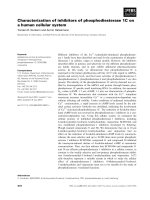
![Báo cáo khóa học: Selective release and function of one of the two FMN groups in the cytoplasmic NAD + -reducing [NiFe]-hydrogenase from Ralstonia eutropha pptx](https://media.store123doc.com/images/document/14/rc/gg/medium_ggg1394180403.jpg)

